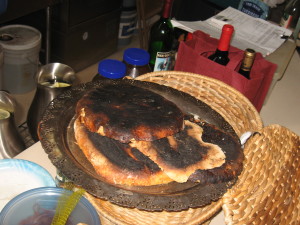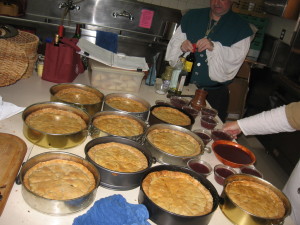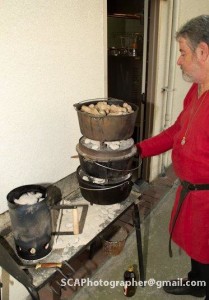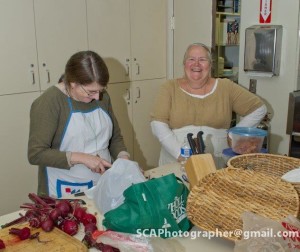My good friend and SCA household Member, Pierre de Dieppe, was the Event Steward for the 2011 Yule event, hosted by his local barony. He asked me to cook the feast! While I had been a part of many feast staffs over the years, I really had no desire to be Feast Steward for any event.  But, he convinced me that this would make a great household project, so I agreed to do it. And it was! Cliar Cu Buidhe really stepped up and did a great job on this event. I was so proud to be a part of it!
But, he convinced me that this would make a great household project, so I agreed to do it. And it was! Cliar Cu Buidhe really stepped up and did a great job on this event. I was so proud to be a part of it!
The theme of the event was to be centered on Nikolaos of Myra, who he was and how the Feast Day of this 4th century Saint Nicholas has been observed throughout the Middle Ages. Pierre’s invitation to the event was my inspiration:
Come and join us as we explore the world in which he lived and died,
and how he continued to influence the lives and celebrations of future
generations, including our own. We all join one another today as simple
pilgrims and travelers, to gather together in the cold of winter and
celebrate the passing of the dark and the spring soon to arrive!
While I know little of 4th century cuisine, I loved the idea of celebrating the season with foods of the season. So, looking to my trusted 14th century repertoire, and my local Farmers’ Market, I came up with the following menu to feed the day’s 100 pilgrims:
<><><>
First Course: A traditional Chestnut Soup, made with fresh roasted chestnuts, vegetable stock and cream. It is served with fresh bread, Brie cheese and a Fig & Raisin Puree.
Second Course: A Salmon/Leek Pie, made with wine & spices. It is served with Domhnall’s Famous Pork Sausage on a bed of Sour Cabbage.
Third Course: A dish of seasoned Stewed Beef, served with roasted root vegetables of the season, stewed pears in wine syrup, with mushrooms & cheese pasties.
Fourth Course: A tray of assorted sweets, including Speculaas cookies, honey pine nut candy with shortbread, and dates stuffed with honeyed walnuts or candied orange peel.
In addition, Cliar Cu Buidhe offers you a Hypocras, made by Lord Frederic de Cherbourg in cups thrown by THL Beathog. Please enjoy the drink and take the cup home as your Yule gift. We hope you have enjoyed your feast. Happy Yule!
<><><>
Notes on the First Course:
Chestnuts! I didn’t have an actual period recipe for the chestnut soup. Chestnuts were quite commonly eaten during the 14th century. There are actual recipes for their use in Le Viandier de Taillevent, Ménagier de Paris, and chestnuts were mentioned in Chaucer, as well. They were often kept on hand for eating, like nuts. Considered a “heavy fruit”, and difficult to digest, they were often served at the end of the meal. But, they were also commonly ground into flour, to serve as a grain substitute in baked goods. Would they also serve as a thickener in soups, just as bread was? Why not?! In this case, they were ground and added to a vegetable soup “base” of leek, celery, carrot and onion and seasoned with thyme. Delicious!
Unfortunately, Domhnall suffered with this dish. Our budget did not allow us to use peeled chestnuts, but we were able to obtain a vast amount of fresh chestnuts at a very reasonable price. After hours of research (and more YouTube videos than I care to count), we thought we had found the perfect method for peeling the hot chestnuts. NO! Each method we tried (read: Each method DOMHNALL tried) worked for a few chestnuts, but then, NO. Twenty-five pounds of chestnuts, probably that many hours later spent peeling them, and we had a beautiful soup! In our house, I’m not allowed to mention the soup to this day. Fortunately, the memory of that deliciousness will live in our hearts for years to come…
 The bottom crusts of bread, blackened from the floor of the oven, were removed from the loaves before serving to the guests. The “alms” were placed on silver trays and presented to High Table, to Their Excellencies, the Baron and Baroness of Lyondemere, the Baron and Baroness of Gyldenholt, and the Reeves of Gyldenholt, before being offered to the servants, the dogs, or the poor.
The bottom crusts of bread, blackened from the floor of the oven, were removed from the loaves before serving to the guests. The “alms” were placed on silver trays and presented to High Table, to Their Excellencies, the Baron and Baroness of Lyondemere, the Baron and Baroness of Gyldenholt, and the Reeves of Gyldenholt, before being offered to the servants, the dogs, or the poor.
The soup was served with fresh bread, which I made over the period of several days, Brie cheese and Fygey, from the Forme of Cury:
Take almaundes blaunched; grynde hem and drawe hem vp with water and wyne, quarter fyges, hole raisouns. Cast þerto powdour gynger and hony clarified; seeþ it wel & salt it, & serue forth.
Blanched almonds, ground and mixed with water and a little white wine. Cook gently and stir in chopped figs and raisins,seasoned with ginger and sweetened with a bit of honey.
The cheese aided digestion and helped to “open the stomach”, the bread itself, easily digestible, and the ginger warmed and helped open the stomach, as well.
<><><>
Notes on the Second Course:
My salmon & leek pie was adapted from Ein Buch von guter spise:
19. Diz ist ein gut spise von eime lahs (This is a good food of a salmon)
Nim einen lahs. schabe im abe die schupen. spalde in und snit in an stücke. hacke peterlin selbey. Nim gestozzen yngeber pfeffer enys saltz zu mazzen. mache eynen derben teyk noch der groezze der stucke. und wirf daz krut uf die stücke. und bewirke sie mit dem teyge. kanst du sie gestemphen in ein forme daz tu. so mahtu machen hechde. förheln brasmen und backe eigliches besunder in eime teyge. ist ez aber eins fleischtages. so mahtu machen hüenre, rephüenre, tuben und vasande mahtu machen. ab du hast die formen. und backe sie in smaltze oder siut sie in den formen. nim von den brüsten der hüenre oder ander gut fleisch. so wirt die kunst dests bezzer und fersaltzez.
Take a salmon. Scrape off the scales. Split it and cut it into pieces. Cut parsley (and) sage. Take ground ginger, pepper, anise. Salt to mass. Make a dough (possibly freshly made as opposed to sourdough) also the size of the piece (of salmon). And throw the herb on the piece. And surround it with the dough. Stamp it in a form if you can. Thus you may make pike (and) trout. And bake individually in a dough. However, if it is a meat day, then you may make hens, partridge, pigeon and pheasant. If you have the forms, and bake them in fat or boil in the forms. Take from the breasts of the hens or other good meat. So will the art be the better and do not over salt.
I used poached salmon, sauteed leeks, salt & pepper, parsley, sage and ginger. I omitted the anise. The pies were served with Cameline Sauce, one of the most common sauces of the Middle Ages.
 Take faire brede, and cut̘ it̘, and toste it; and take vynegre and wyne, and stepe hit̘ þer-in, and draw it þurwe a straynour wiþ poudre canel, and draw it .ij. or .iij. tymes, til it be smothe. And þanne take poudre ginger, sugre, and poudre of clowes, and cast þer-to. And loke þat̘ it̘ stonde wil by clowes, & by sugre; and þanne put̘ þer-to a litil safroune, and salt, and serue hit forþ þicke y-nowe.
Take faire brede, and cut̘ it̘, and toste it; and take vynegre and wyne, and stepe hit̘ þer-in, and draw it þurwe a straynour wiþ poudre canel, and draw it .ij. or .iij. tymes, til it be smothe. And þanne take poudre ginger, sugre, and poudre of clowes, and cast þer-to. And loke þat̘ it̘ stonde wil by clowes, & by sugre; and þanne put̘ þer-to a litil safroune, and salt, and serue hit forþ þicke y-nowe.
Bread was toasted, ground to crumbs, and mixed with vinegar and wine. It was then spiced with cinnamon, ginger and cloves, saffron, salt, and sweetened with sugar.
<><><>
Domhnall’s Famous Pork Sausages were spiced with just the right amount of our own house Poudre Forte spice blend and cooked in my own homemade sauerkraut. The pork and sauerkraut were cooked in four Dutch ovens, each stacked upon the other. This is a “personal best” for Domhnall. This picture shows three of the ovens, as he is prepping them for the fire. The ovens must be heated (and cooled) gradually, or they may crack. He places the oven on the hot coals beneath and allows it to warm a bit before adding the lid and the top layer of coals.
<><><>
Notes on the Third Course:
The Stewed Beef was a very successful dish! For ease of serving, we used boneless short ribs, but added beef soup bones to the pot for added flavor. Note that we did not boil it in a pot, but cooked it in the oven. We used this recipe, but omitted the cloves and sandalwood.
Take faire Ribbes of ffresh beef, And (if thou wilt) roste hit til hit be nygh ynowe; theñ put hit in a faire possenet; caste þer-to parcely and oynons mynced, reysons of corauns, powder peper, canel, clowes, saundres, safferoñ, and salt; theñ caste there-to wyñ and a litull vynegre; sette a lyd oñ þe potte, and lete hit boile sokingly on a faire charcole til hit be ynogh; þeñ lay the fflessh, in disshes, and the sirippe there-vppoñ, And serve it forth.
Take fair ribs of beef, and if you will roast it until nearly done; then put it in a fair pot; add parsley and onions minced, raisins of Corinth, pepper, cinnamon, cloves, sandalwood, saffron, and salt; then add to this wine and a little vinegar; set a lid on the pot, and let it boil well on a fair charcoal until done; then lay the flesh in disshes, and the syrup on top, and serve forth.
<><><>
We served the beef with roasted seasonal vegetables: carrots, turnips, squash, parsnips, onions, beets, fennel root and garlic, with olive oil and fresh rosemary.
<><><>
The meatless option for this course included mushroom & cheese pasties. My recipe was a redaction of the following, from the 14th c. Le Ménagier de Paris (The Goodman of Paris):
Mushrooms of one night be the best and they be little and red within and closed at the top; and they must be peeled and then washed in hot water and parboiled and if you wish to put them in a pasty add oil, cheese and spice powder.
<><><>
<><><>
My mushrooms were not, however, peeled, nor were they washed in hot water! I sauteed them lightly in olive oil, to reduce the water and add additional flavor, before mixing in the cheese and spices. I also added a bit of parsley (because I had it and I like it).
<><><>
<><><>
We added our favorite radish mice to some of the trays before service, a “mice creatures are stirring” subtlety for Yule.
<><><>
Pears, considered both a rich and exotic food, were saved for this course because they, along with the beef were considered to be more difficult to digest.
As the pears would be also slightly out of season, they had been preserved in a syrup of wine and spices, as the following recipe:
Wardonys in syryp.—Take wardonys, an caste on a potte, and boyle hem till þey ben tender; þan take hem vp and pare hem, an kytte hem in to pecys; take y-now of powder of canel, a good quantyte, an caste it on red wyne, an draw it þorw a straynour; caste sugre þer-to, an put it [in] an erþen pot, an let it boyle: an þanne caste þe perys þer-to, an let boyle to-gederys, an whan þey haue boyle a whyle, take pouder of gyngere an caste þer-to, an a lytil venegre, an a lytil safron; an loke þat it be poynaunt an dowcet.
Pears in Syrup. Take pears, and place in a pot, and boil until tender; take out and pare, and cut into pieces; take a large quantity of cinnamon, and add it to red wine, and pass through a strainer; add sugar, and place in an earthenware pot, and bring to a boil: and add the pears and let boil, and after awhile add ginger and a little vinegar and saffron; and see that it be both sour and sweet.
<><><>
Notes on the Fourth Course:
The tray of assorted sweets included cookies and candies made by Lord Pierre, Lady Etiennette and Lady Avicia. What a delicious variety and addition to my stuffed dates! My dates were stuffed with both a honeyed walnut and a candied orange peel, both being my own redactions from a 2009 Pentathlon entry.
Lord Frederic ended the feast with an offering of his own Hypocris, a spiced wine, and a toast to the Barons, the Baronesses, the Reeves, the King and Queen, and Caid. Huzzah!
<><><>
<><><>
Thank you, Drach Medved and Lady Etiennette Dubord Dite Desmarais, for a few of the pictures (I think) I stole from you! With pictures appearing here and there and everywhere on Facebook, you can’t always be sure where they come from!
And thank you, Cliar Cu Buidhe, for helping me make a delicious and memorable feast!
“S ann nas fheàrr a bhith fìor ceart ‘sa linn.”







